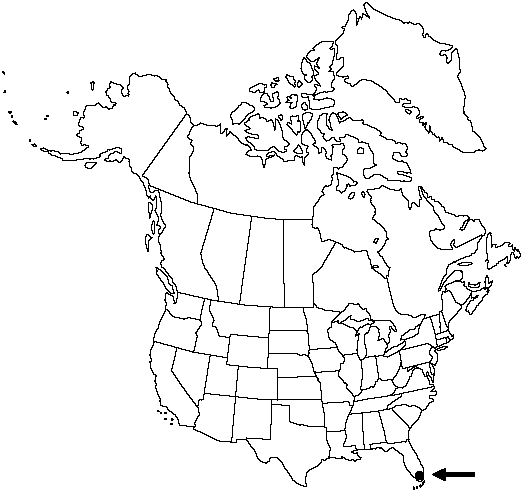Difference between revisions of "Campyloneurum latum"
Index Fil. 225. 1861.
FNA>Volume Importer |
imported>Volume Importer |
||
| (7 intermediate revisions by 2 users not shown) | |||
| Line 12: | Line 12: | ||
|name=Polypodium latum | |name=Polypodium latum | ||
|authority=(T. Moore) Sodiro | |authority=(T. Moore) Sodiro | ||
| + | |rank=species | ||
}} | }} | ||
|hierarchy=Polypodiaceae;Campyloneurum;Campyloneurum latum | |hierarchy=Polypodiaceae;Campyloneurum;Campyloneurum latum | ||
| Line 20: | Line 21: | ||
}}<!-- | }}<!-- | ||
| − | --><span class="statement" id="st- | + | --><span class="statement" id="st-undefined" data-properties=""><b>Stems </b>short-creeping, to 7 mm diam. <b>Leaves</b> few to many, erect to arching. <b>Petiole</b> 5–18 cm. <b>Blade</b> dark green, oblong, elliptic to oblanceolate, 20–60 cm × 4–9 cm [larger], leathery; base cuneate; apex abruptly acute. <b>Veins</b> obvious, primary veins ± prominent, straight to slightly curved, areoles in 8–18 series between costa and margin, with free included veinlets, a percurrent veinlet often dividing some areoles further. <b>Sori</b> in several rows on each side of costa.</span><!-- |
-->{{Treatment/Body | -->{{Treatment/Body | ||
| Line 26: | Line 27: | ||
|elevation=0 m | |elevation=0 m | ||
|distribution=Fla.;Mexico;West Indies;Central America;South America. | |distribution=Fla.;Mexico;West Indies;Central America;South America. | ||
| − | |discussion=<p>The venation of Campyloneurum latum is similar to, but more variable than, that of C. phyllitidis.</p><!-- | + | |discussion=<p>The venation of <i>Campyloneurum latum</i> is similar to, but more variable than, that of <i>C. phyllitidis</i>.</p><!-- |
| − | --><p>The only record in the flora is based on a collection by J. J. Soar and A. A. Eaton in December 1903 from Dade County, Florida (A. A. Eaton 1906). Extensive searches at the original collection site and many other likely locations in the southern portions of Florida have failed to turn up any plant that could be called Campyloneurum latum. The species is apparently extirpated from North America north of Mexico.</p> | + | --><p>The only record in the flora is based on a collection by J. J. Soar and A. A. Eaton in December 1903 from Dade County, Florida (A. A. Eaton 1906). Extensive searches at the original collection site and many other likely locations in the southern portions of Florida have failed to turn up any plant that could be called <i>Campyloneurum latum</i>. The species is apparently extirpated from North America north of Mexico.</p> |
|tables= | |tables= | ||
|references= | |references= | ||
| Line 36: | Line 37: | ||
-->{{#Taxon: | -->{{#Taxon: | ||
name=Campyloneurum latum | name=Campyloneurum latum | ||
| − | |||
|authority=T. Moore | |authority=T. Moore | ||
|rank=species | |rank=species | ||
| Line 50: | Line 50: | ||
|publication year=1861 | |publication year=1861 | ||
|special status= | |special status= | ||
| − | |source xml=https:// | + | |source xml=https://bitbucket.org/aafc-mbb/fna-data-curation/src/2e0870ddd59836b60bcf96646a41e87ea5a5943a/coarse_grained_fna_xml/V2/V2_105.xml |
|genus=Campyloneurum | |genus=Campyloneurum | ||
|species=Campyloneurum latum | |species=Campyloneurum latum | ||
| − | |||
| − | |||
| − | |||
| − | |||
| − | |||
| − | |||
| − | |||
| − | |||
| − | |||
| − | |||
| − | |||
| − | |||
| − | |||
| − | |||
| − | |||
| − | |||
| − | |||
| − | |||
| − | |||
}}<!-- | }}<!-- | ||
-->[[Category:Treatment]][[Category:Campyloneurum]] | -->[[Category:Treatment]][[Category:Campyloneurum]] | ||
Latest revision as of 21:21, 5 November 2020
Stems short-creeping, to 7 mm diam. Leaves few to many, erect to arching. Petiole 5–18 cm. Blade dark green, oblong, elliptic to oblanceolate, 20–60 cm × 4–9 cm [larger], leathery; base cuneate; apex abruptly acute. Veins obvious, primary veins ± prominent, straight to slightly curved, areoles in 8–18 series between costa and margin, with free included veinlets, a percurrent veinlet often dividing some areoles further. Sori in several rows on each side of costa.
Habitat: Epiphytic in tropical hammocks
Elevation: 0 m
Distribution

Fla., Mexico, West Indies, Central America, South America.
Discussion
The venation of Campyloneurum latum is similar to, but more variable than, that of C. phyllitidis.
The only record in the flora is based on a collection by J. J. Soar and A. A. Eaton in December 1903 from Dade County, Florida (A. A. Eaton 1906). Extensive searches at the original collection site and many other likely locations in the southern portions of Florida have failed to turn up any plant that could be called Campyloneurum latum. The species is apparently extirpated from North America north of Mexico.
Selected References
None.